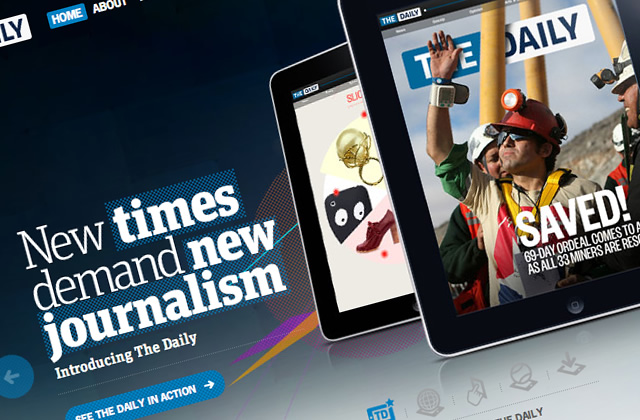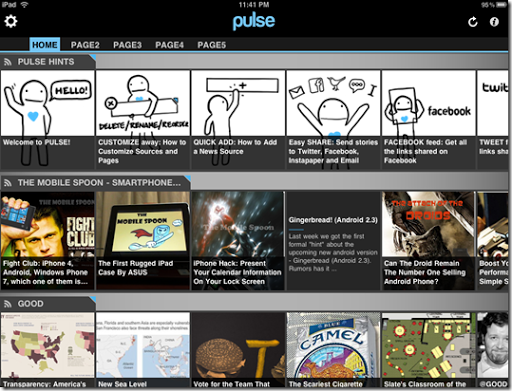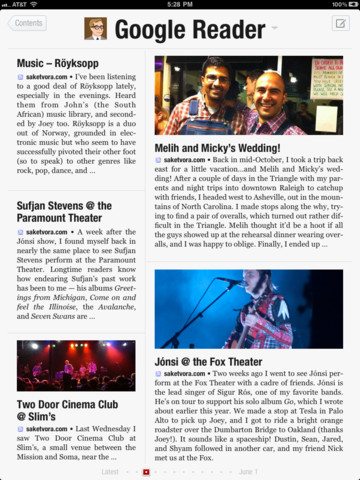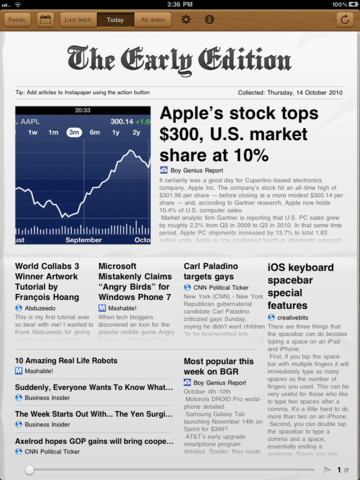iPad and news: a small overview of the best apps

The recently released The Daily for iPads triggered a wave of publications about the future of news in the tablet world. Meanwhile, there is nothing revolutionary in this event, except, perhaps, for the first time a subscription model appeared in the AppStore, and everyone has been waiting for this for a long time. As for the “new innovative” interface, it will be useful to compare The Daily with the already existing news apps for iOS.
iPad versions of traditional newspapers and magazines
')
In the first months after the start of sales of the iPad, almost all leading American newspapers released their versions for it: The New York Times , The Wall Street Journal , The Financial Times , etc., as well as many magazines. Especially a lot of noise has been done by the specialized number from Wired , which the truth has remained in the singular, the other numbers are full analogs of the printed ones. The Daily interface and content foundations were already laid then - a “gesture” transition between sections and pages, a lot of photos and video inserts. Here, for example, the interface of the Time magazine is quite a pre-thedaily era.
Even the Russian-language publications did not lag behind, their applications appeared in Kommersant , Vedomosti , Komsomolskaya Pravda , Snob , information agencies (RIAN) were connected, a very decent automobile magazine Autotrails appeared .

Social news
Even more interesting processes occur on the front of social and RSS aggregators, which, on the one hand, are inspired by newspaper and magazine layout, and on the other hand, are not limited to one source of content and allow the user to influence what falls into his field of news interests.
Pulse
One of the pioneers in this area was the Pulse app, released first for the iPhone, and then for the iPad.

Being essentially an RSS reader with a pre-installed feed catalog and incomplete integration with Google Reader, Pulse turns blogs into news panels with small pictures and explanations. You can scroll it horizontally (watch the rest of the posts of a particular blog), you can - vertically (scroll the blogs themselves). Personally, at the sight of Pulse, I had an association with a wall of screens in television installation rooms.
Another application - Flipboard - automatically generates almost magazine pages from your Twitter and Facebook feeds, from Google Reader subscriptions, as well as recommended Twitter sources.

The application is also convenient because it automatically pulls links and photos from tweets and FB-statuses and places emphasis on them. It is interesting and unusually decided to “flipping” pages (the same flip appearing in the title) - this is easier to show than to explain.
Early edition
An application that stands out among other RSS readers with its similarity to newspapers and their iPad counterparts, while the content consists entirely of posts on your favorite blogs.

In short, I will mention a couple of worthy applications for the iPhone - Feedly and Smartr. Feedly historically appeared as a plugin on top of Google Reader, conveniently structuring and automatically prioritizing the flow of messages from numerous feeds based on popularity among other users. Very handy for those who have too many subscriptions. Smartr is a Twitter client, but its feed is not formed from tweets, but from the preview of the links contained in tweets. In this case, you can read the text on the link completely, it will be “mobilized”, that is, adapted for viewing on the smartphone screen.


PS: and what news applications do you use? Is everything happy or missing something?
Source: https://habr.com/ru/post/113425/
All Articles